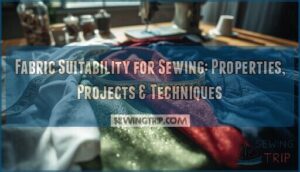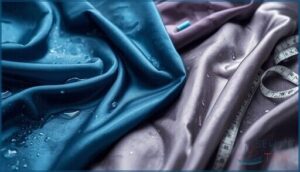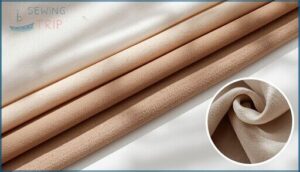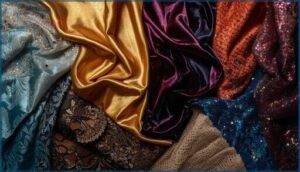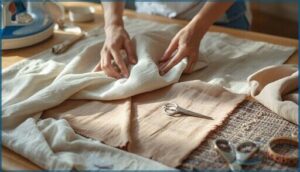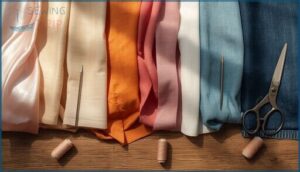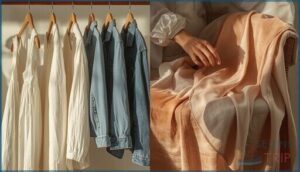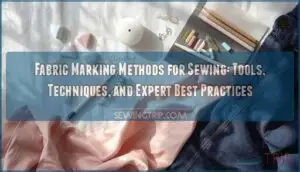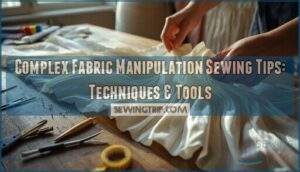This site is supported by our readers. We may earn a commission, at no cost to you, if you purchase through links.
You pull fabric off the shelf, feel the texture between your fingers, and wonder if it’ll cooperate with your machine—or turn your project into a frustrating mess. That instinct to test the material before you commit? It’s rooted in real science.
Fabric suitability for sewing hinges on measurable properties: a cotton’s tendency to shrink 3-5% after washing, polyester’s twenty-fold advantage in abrasion resistance, or how a fabric’s GSM (grams per square meter) predicts whether your needle will glide or struggle.
When you match fiber content, weight, and structure to your project’s demands, you’re not guessing—you’re engineering success. Understanding what makes one fabric perfect for a flowing dress and another ideal for heavy upholstery gives you the control to choose confidently every time.
Table Of Contents
- Key Takeaways
- Key Factors in Fabric Suitability for Sewing
- Comparing Natural and Synthetic Fabrics
- Matching Fabric to Sewing Projects
- Assessing Fabric Quality and Preparation
- Essential Sewing Techniques by Fabric Type
- Fabric Performance and Care Considerations
- Top 4 Fabrics for Sewing Projects
- Frequently Asked Questions (FAQs)
- Conclusion
Key Takeaways
- Fabric performance depends on measurable properties like GSM (grams per square meter), fiber content, and stretch recovery rates—cotton shrinks 3-5% while polyester delivers twenty times more abrasion resistance, so matching these specs to your project’s demands eliminates guesswork.
- Pre-washing fabric removes 95% of shrinkage potential and prevents seam puckering, with cotton losing 3-5%, linen up to 7%, and wool 5-8%, making this step critical before you cut a single piece.
- Wrong needle-fabric pairings cause 22% more thread breakage and visible damage, so lightweight chiffon needs 60/8 sharp needles while dense denim requires 100/16 denim needles to prevent project failure.
- Choosing the wrong fabric causes 68% of abandoned sewing projects, proving that testing stretch recovery, verifying weight ratings, and matching needle size to fabric density transforms uncertain attempts into mastered techniques.
Key Factors in Fabric Suitability for Sewing
Choosing the right fabric isn’t just about what catches your eye—it’s about understanding what works for your specific project. The fabric you select determines everything from how easy your garment is to sew to how long it’ll last after countless wears and washes.
Let’s break down the core properties you need to evaluate before you make that first cut.
Fiber Content and Composition
Fiber content shapes everything about your fabric’s performance. Natural fabrics like cotton absorb up to 25% of their weight in moisture, making them breathable winners for everyday wear. Synthetic fabrics such as polyester deliver twenty times more abrasion resistance, perfect when durability matters.
Fiber blending combines these strengths—a 60/40 cotton-polyester mix balances comfort with resilience. Understanding yarn quality, fabric density, and material science gives you control over every project’s outcome.
The choice of fabric also depends on the fiber manufacturing process, which affects the environment and product sustainability.
Fabric Weight and Thickness
Weight measurement matters just as much as composition. You’ll find GSM (grams per square meter) governs fabric density across all your projects. Lightweight materials at 50–150 GSM suit summer garments, while heavyweight options above 350 GSM deliver the durability you need for upholstery and outerwear.
Thickness ranges directly affect sewing performance:
- 100–200 GSM manages shirts and lightweight bedding with ease
- 200–300 GSM powers through sweatshirts and casual pants
- 300–500 GSM manages blankets and winter apparel
- Over 500 GSM manages canvas, denim, and heavy-duty applications
Heavier fabrics resist seam pucker and maintain shape better under tension. You’ll adjust needle size and stitch length based on thickness to prevent defects and achieve professional results every time. Understanding fabric weight basics is essential for selecting the right material for your sewing projects.
Drape and Structure
Beyond weight lies drape—how your fabric hangs and flows under gravity. The drape coefficient measures this: limp fabrics score below 30%, while stiff materials exceed 85%. Silk cascades softly for elegant garment silhouettes, whereas denim holds its shape for structured jackets.
You’ll choose based on your vision—flowing curtains demand high textile deformation, while structured blazers require structural integrity that resists fabric stretch.
Stretch and Recovery
Elastic properties define how your stretch fabrics behave under tension. Jersey knits usually stretch 40% to 60%, while spandex blends reach 100%. Recovery rates matter even more—high-quality materials bounce back at least 85% after stretching.
Synthetic fibers like elastane deliver excellent moisture-wicking and fabric durability, maintaining their shape through repeated wear.
Run stretch tests before cutting to avoid fabric fatigue that ruins your project’s fit.
Texture and Surface Finish
Surface finish dramatically changes how your fabric behaves during sewing. Fabric roughness in the weft direction runs 20–30% higher than in the warp, creating uneven sewing friction that affects seam formation.
Wool’s texture analysis reveals a 30% roughness decrease after 50 abrasion cycles. Material smoothness matters because rough fabric types demand different needle pressures and thread tensions than smooth natural fibers.
Comparing Natural and Synthetic Fabrics
When you’re standing in the fabric store, the choice between natural and synthetic materials can make or break your project. Each type brings its own strengths to the table—cotton breathes, polyester lasts, and blends give you the best of both worlds.
Let’s break down what you need to know about natural fabrics, synthetics, blends, and specialty materials so you can pick the right one every time.
Common Natural Fabrics and Their Uses
You’ll find cotton dominating your sewing room—it represents 40% of the global textile market thanks to its breathability, durability, and color retention.
Linen properties shine in warm-weather projects with moisture-wicking abilities that keep you cool. Wool benefits include absorbing up to 30% moisture without feeling damp, perfect for winter garments.
Silk production may be under 1% globally, but its 600 MPa tensile strength and hypoallergenic qualities make it ideal for luxury pieces.
Hemp applications extend beyond fashion into industrial textiles.
Synthetic Fabrics: Properties and Benefits
Synthetic fabrics like polyester and nylon deliver outstanding fabric durability—tensile strengths reach 4.5 to 9 grams per denier. These synthetic fibers resist wrinkles and stains while offering elastic recovery that maintains shape through repeated wear.
You’ll appreciate their moisture-wicking performance that accelerates sweat evaporation during active projects.
With quick-drying properties and machine-washable care, synthetic blends bring textile innovation to everyday sewing at cost-effective prices.
Fabric Blends for Balanced Performance
Fabric blending combines natural breathability with synthetic durability—cotton/polyester ratios like 60:40 balance comfort and strength perfectly. These performance textiles deliver moisture management better than single fibers while cutting shrinkage below 2% per wash.
- Blend ratios at 50:50 enhance wrinkle resistance and quick-dry properties
- Sustainable fabrics now incorporate up to 50% recycled polyester with Tencel
- Proper fabric selection using blends reduces production costs by 20%
You’ll master fabric properties that outlast pure cotton by over 30% in durability tests.
Specialty Fabrics for Unique Projects
Geotextile applications and medical textiles demand specialized engineering—think reinforced infrastructure fabrics or biomedical components requiring ultrasonic welding. Smart fabrics with embedded sensors transform technical knits into performance gear, while eco-innovations like biodegradable hemp answer sustainability demands.
Traditional luxury materials—silk, velvet, lace, brocade, and sequins—still require precision sewing techniques. However, moisture-wicking and flame-retardant specialty textiles now dominate industrial markets worth $10.7 billion.
Matching Fabric to Sewing Projects
Choosing the right fabric isn’t about memorizing charts—it’s about understanding how material properties align with your project’s demands. The fabric that works beautifully for a summer dress will fail miserably as upholstery, and what makes great outerwear won’t necessarily suit a delicate scarf.
Choosing the right fabric means understanding how its properties match your project’s specific demands, not just memorizing charts
Let’s match specific fabrics to real projects so you can make confident decisions from the start.
Apparel: Everyday Wear, Outerwear, and Formal Attire
Your wardrobe choices start with fabric fundamentals. For everyday wear, cotton dominates 20-30% of casual apparel—think breathable t-shirts and jeans that balance comfort with durability.
Outerwear demands sophisticated synthetic blends with moisture-wicking properties, now holding 39% market share in performance textiles.
Formal attire? You’ll want luxury natural fabrics like silk and wool, though sustainable materials are reshaping fashion innovation. Each category requires specific fabric trends that determine garment longevity and versatility.
Home Decor and Upholstery
When you’re tackling furniture restoration or revamping your living space, upholstery materials demand different priorities than apparel. Polyester dominates 37% of residential fabric selection for good reason—it’s durable and affordable. Cotton blends claim 28% of home textiles, while natural fabrics like linen provide cooling comfort.
Fabric durability matters here: expect high-quality cotton upholstery to last 5–10 years, with proper weaving techniques and decor trends influencing performance under daily use.
Accessories and Craft Projects
Unlike furniture-facing demands, your handmade accessories prioritize softness and visual appeal over raw durability. Cotton dominates 67% of craft fabric purchases because it’s adaptable and easy to handle. Jersey knit saw a 13% rise in headbands and hats thanks to its stretch properties, while canvas and denim anchor 11% of projects needing structure:
- Tote bags demand canvas or denim for lasting strength
- Fleece and plush fabrics create irresistible stuffed animals
- Satin and tulle add elegance to formal accessories
Considering Weather and Activity
Your adventure demands more than pretty fabric. Wool regulates warmth while wicking 30% of its weight in moisture—perfect when activity levels spike unexpectedly. Polyester mesh delivers exceptional breathability and moisture-wicking for high-intensity work, drying faster than natural fibers.
Cotton and linen excel in humid heat thanks to steady airflow, though durability suffers outdoors. Match thermal insulation and weather resistance to your plans, not just aesthetics.
Assessing Fabric Quality and Preparation
You can’t build a great project on shaky ground, and that principle holds true when you’re selecting fabric. Quality matters as much as type, and how you prep your material before the first stitch determines whether your finished piece looks sharp or sloppy.
Here’s what you need to assess and prepare before your needle hits the cloth.
Identifying High and Low-Quality Fabrics
When you’re looking at fabric, quality control starts with your own hands and eyes. The difference between a fabric that’ll last years and one that falls apart in months often comes down to details you can spot right away.
- Check the weave or knit structure for consistency—gaps, loose threads, or irregularities signal poor textile grading and reduced durability
- Examine thread count and density, as premium natural fabrics usually exceed 200 threads per inch while synthetic fabrics should show tight, uniform construction
- Inspect for defects like stains, color bleeding, snags, or distortions through proper fabric inspection methods
- Review fiber content labels carefully, since high-quality materials contain at least 80% identifiable natural or premium synthetic fibers with clear care instructions
Pre-Washing and Shrinkage Prevention
Pre-washing locks in your control over the final garment dimensions. Cotton shrinks 3-5% after its first wash, linen up to 7%, and wool around 5-8%, while synthetics like polyester stay under 2%. Running fabric through the same wash you’ll use for the finished piece removes 95% of shrink potential and relaxes fibers to prevent seam puckering.
| Fabric Type | Typical Shrinkage Rate | Pre Wash Benefits |
|---|---|---|
| Cotton | 3–5% | Eliminates residual sizing, prevents distortion |
| Linen | Up to 7% | Relaxes fibers, reduces wrinkles |
| Wool | 5–8% | Stabilizes dimensions, softens texture |
| Polyester | <2% | Removes odors, improves moisture wicking |
| Blends | Variable (depends on fiber ratio) | Balances shrinkage, enhances durability |
Always test a 5-inch swatch before and after washing to measure exact fabric shrinkage. For high-shrinkage materials, prewashing twice ensures you’re working with stabilized yardage. This simple step protects your investment and guarantees consistent fabric care throughout the garment’s life.
Pressing, Ironing, and Handling Techniques
You’ll master heat protection by matching iron temperature to fabric properties—cotton and linen handle up to 204°C, while synthetics demand 135°C or less to prevent melting.
Always press with an up-and-down motion rather than sliding to avoid distortion.
Use pressing tools like cover cloths on wool and silk to maintain durability and block shine, ensuring proper fabric care and seam finishing without scorching.
Aligning Pattern Pieces and Grainlines
Before cutting, you’ll position the pattern’s double-pointed grainline arrow parallel to the selvage edge—this ensures seam stability and proper fabric drape. Pin one end, measure the distance to selvage at both points, and adjust until they match exactly.
Key grainline directions that affect fabric stretch and cutting accuracy:
- Lengthwise grain – Maximum stability for structured pieces
- Crosswise grain – Slight horizontal stretch for comfort
- Bias grain – Fluid drape at 45-degree angles
Essential Sewing Techniques by Fabric Type
You can’t master every fabric with the same approach. Different materials demand specific needles, feet, and handling techniques to get professional results without frustration.
Here’s what you need to know to work confidently with any textile that comes across your sewing table.
Needle Selection for Different Fabrics
Your needle selection directly determines whether your stitches form cleanly or your project fails. Wrong sewing needles cause up to 22% more thread breakage and create visible damage in fabric density variations. Match needle size and type to fabric properties—lightweight chiffon demands 60/8 sharp needles to prevent snags, while dense denim requires 100/16 denim needles that withstand fabric friction. Titanium-coated options boost needle durability by 40%, maintaining consistent thread tension even at high sewing speeds.
| Fabric Type | Recommended Needle |
|---|---|
| Cotton/Linen | Universal 80/12–90/14 |
| Silk/Chiffon | Sharp needle 60/8–70/10 |
| Denim/Canvas | Denim needle 100/16–110/18 |
| Jersey/Knits | Ballpoint 70/10–80/12 |
| Leather | Wedge-point 90/14–110/18 |
Sewing Machine Feet for Challenging Textiles
Your sewing machine feet transform challenging textiles from frustrating obstacles into controlled projects. Walking feet reduce seam puckering by 65% on slippery ripstop and coated fabrics, while Teflon feet cut friction by 80% on sticky vinyl and leather.
Roller feet increase speed 30% on textured velvet and suede.
Overedge feet prevent fraying in 90% of apparel factories, and quarter-inch feet deliver precise seam allowances for patchwork accuracy.
Managing Slippery, Stretchy, and Thick Fabrics
You conquer difficult textiles by matching your fabric slippage prevention strategy to the material. Slippery fabric tips include spray starch reducing handling issues by 60%, while stretchy sewing demands polyester thread for 10–15% seam elongation.
Thick fabric handling requires these seam integrity techniques:
- Increase needle size to 90/14 for 75% fewer breaks
- Hand-crank through dense layers preventing 86% of jams
- Flatten seam bulk with a hammer cutting height 50%
Finishing Raw Edges and Preventing Fraying
After you’ve managed tricky materials, protecting raw edges becomes your next move. Serger machines cut fraying by 90% on woven fabrics, while zigzag stitches offer 75% less edge decomposition for lighter textiles.
Edge binding encapsulates raw areas for near-zero thread loss across 50 wash cycles. Fabric sealing with liquid fray preventers works brilliantly on synthetics, reducing degradation by 80%.
Your seam finishes determine long-term durability and fabric care success.
Fabric Performance and Care Considerations
You’ve mastered the technical side of sewing, but your fabric choices mean nothing if your finished projects fall apart after a few washes or lose their shape by next season. The real test of fabric suitability isn’t how it behaves under your needle—it’s how it performs in the real world.
Let’s look at the key performance factors that separate projects you’ll treasure for years from ones that end up as cleaning rags.
Durability, Maintenance, and Longevity
Your fabric’s lifespan hinges on three pillars: construction quality, fiber composition, and how you treat it. Heavy-duty upholstery that endures 15,000+ rubs lasts a decade with proper maintenance practices, while cotton’s textile longevity depends on weave density and thread count.
Combat fiber degradation by vacuuming regularly to remove abrasive particles, pre-washing before storage, and using gentle detergents. Durability testing shows that fabric abrasion resistance varies dramatically—choosing wisely means investing in projects that truly last.
Breathability and Comfort
Your sewn garments need more than durability—they need to breathe. Air permeability determines how well fabric lets air pass through, with linen scoring 200-300 L/m²/s for summer comfort while denim’s 50 L/m²/s blocks airflow.
Moisture management matters too: cotton absorbs 25% of its weight in water, but polyester activewear achieves moisture-wicking rates exceeding 10,000 g/m²/24hr. Natural fabrics offer softness and breathability; synthetics excel at moving sweat away from your skin.
Cleaning and Storage Guidelines
Understanding fabric care and laundry methods keeps your projects fresh for years. Check washing instructions on care tags—77% of sewers rely on them—and wash in cold water to preserve textile integrity. Pre-washing reduces shrinkage by 85% in cotton and wool.
Store fabrics at 40-50% humidity to prevent mold and extend shelf life to 5-10 years. Proper humidity control protects your investment.
Sustainability and Eco-Friendliness
Choosing sustainable materials transforms your sewing into a powerful environmental statement. Eco-friendly fabrics like organic cotton and recycled polyester cut carbon emissions by up to 50%, while biodegradable options decompose naturally instead of lingering in landfills for decades.
Green manufacturing and recycling textiles now account for 20% of global textile waste recovery—your choice matters.
Natural fibers breathe better and usually require fewer harsh chemicals during production.
Top 4 Fabrics for Sewing Projects
You’ve learned the theory behind fabric selection, preparation, and performance—now it’s time to see how that knowledge translates into real materials.
The fabrics below represent four distinct categories that’ll expand your sewing toolkit, each offering unique properties and project possibilities.
Let’s look at what makes these materials stand out and when you’ll want to reach for them.
1. Natural Cotton Muslin Fabric Material
You’ll find few fabrics as forgiving and adaptable as cotton muslin when you’re ready to master new sewing techniques. This 100% cotton natural fabric features a plain weave structure with thread counts ranging from 40 to 200, giving you a smooth texture that’s perfect for pattern testing and everyday projects.
Muslin’s breathability and moisture-wicking properties make it ideal for apparel, while its neutral color lets you focus on perfecting your fabric selection skills.
Pre-wash it to prevent shrinkage, and you’ll have a reliable canvas for building confidence in cotton blends and sophisticated weaving concepts.
Best For: Beginners learning garment construction, pattern makers testing new designs, and crafters who need an affordable, breathable fabric for everyday sewing projects.
- Natural 100% cotton with excellent breathability and moisture-wicking keeps you comfortable in warm weather and works great for summer clothing and baby items.
- Wide 63-inch width and smooth plain weave make it easy to work with for draping, fitting mock-ups, and full-scale quilting or curtain projects.
- Unbleached and hypoallergenic composition is gentle on sensitive skin while remaining durable enough for repeated washing and handling.
- Visible cotton seed flecks in the natural unbleached fabric may require extra prep work or acceptance of a more rustic appearance.
- Fabric can be sheer even after pre-washing, so it might need lining or multiple layers for certain apparel applications.
- Some users find the texture rougher than expected, especially compared to higher thread count or pre-softened cotton fabrics.
2. Pure Mulberry Silk Fabric Yardage
When you’re ready to tackle luxury fabric handling, pure mulberry silk yardage delivers unparalleled finesse with its 2–3 denier filament fineness and satin weave techniques that create a luminous drape. This natural fabric’s 16-momme weight balances delicate hand-feel with a tensile strength exceeding 3.7 g/den, making silk fabric selection strategic for wedding gowns and high-end apparel.
Cool-water hand washing preserves its structural integrity, while low-temperature pressing maintains luster—essential silk yardage applications that distinguish novice work from masterful execution in mulberry silk properties.
Best For: Sewists working on high-end bridal gowns, luxury lingerie, or elegant evening wear who can commit to careful hand washing and low-heat pressing to maintain the fabric’s natural luster and strength.
- Exceptional strength-to-weight ratio (3.7–4.0 g/den tensile strength at just 16 momme) gives you a fabric that’s both delicate-looking and durable enough for structured garments with clean seams.
- The 2–3 denier filament fineness creates an incredibly smooth surface that drapes beautifully and resists snagging during construction when you use the right needle size.
- Pure mulberry silk is naturally biodegradable and breathable, making it comfortable for skin-contact garments like sleepwear and linings while still feeling luxurious.
- Requires gentle hand washing in cool water and air drying—machine washing or hot water will cause noticeable shrinkage and can permanently damage the fiber structure.
- The 45-inch width and pre-cut 1-yard pieces limit your options for larger projects like full-length gowns, potentially creating more seams than you’d want in a single garment.
- Production of mulberry silk uses significantly more water and land compared to newer alternatives (97% more water in recent assessments), which matters if environmental impact is part of your project considerations.
3. Chocolate Brown Suede Leather Sheet
Chocolate brown suede leather sheets transform your leather crafting projects with their 1.2–2.0 mm thickness and velvety chrome-tanned nap. You’ll need a leather needle (size 60–70) and polyester thread to handle this 3–4 oz per square foot material, setting your stitch length to 10–12 per inch for ideal seam strength.
Suede’s fabric characteristics demand careful sewing techniques—use a walking foot to prevent shifting and keep presser foot pressure low. While fabric durability shows wear after 20,000 rubs, proper leather care with suede-specific cleaners maintains that soft texture for years in pouches, patches, and bag trim applications.
Best For: Crafters and leatherworkers creating indoor accessories like pouches, bags, and garment patches who want a soft, workable material with a luxurious look.
- Soft, velvety texture that’s easy to work with using standard leather needles and polyester thread
- Biodegradable within 5–10 years, making it a more sustainable choice than synthetic alternatives
- Perfect thickness (1.2–2.0 mm) for a wide range of projects from bag trim to slipper soles
- Shows visible wear after 20,000 rubs, making it less durable than full-grain leather for high-friction items
- Quality control issues reported by some users, including cuts, slashes, or thickness variations in received sheets
- Low stain resistance and susceptibility to water damage requires immediate cleaning and careful storage
4. British Wool Tweed Craft Squares
British wool tweed craft squares bring the legendary durability of British textiles straight to your crafting table. You’ll work with 100% wool from English and Scottish weavers—herringbone, tartan, and checked patterns measuring roughly 9×9 inches.
These natural fabrics weigh 350-400 grams per meter, making wool crafting manageable for appliqué, patchwork, and accessories. Tweed fabric selection requires universal needles and low stretch awareness during sewing projects.
Their tight weave resists fraying while holding creases beautifully—perfect craft square uses for phone covers, purses, and textured quilts where textile materials need both structure and character.
Best For: Crafters who want authentic British wool with traditional patterns for structured projects like bags, accessories, and quilts that need fabric with character and durability.
- Tight weave naturally resists fraying and holds sharp creases, making it ideal for precise appliqué work and items that need to keep their shape
- Medium weight (350-400 grams per meter) strikes a balance between structure and workability, so you’re not wrestling with overly stiff fabric
- Water-resistant properties and exceptional durability mean finished projects hold up to real-world use without constant babying
- Random pattern selection means you can’t choose specific colors or designs, which might leave you with tweeds that don’t match your vision
- Prone to pilling in high-friction areas, so projects like phone covers or bag handles may develop fuzzballs over time
- Requires dry cleaning for finished items to avoid shrinkage and distortion, adding ongoing maintenance costs
Frequently Asked Questions (FAQs)
How do I fix puckered seams after sewing?
You’ve just discovered a puckered seam on your carefully crafted blouse—frustrating, right? Start with steam pressing for fabric relaxation, then adjust thread tension and reduce presser foot pressure.
For severe cases, clip strategic points, resew with proper stitch length adjustments, and consider seam finishes or zigzag stitch for pucker prevention.
Can I combine different fabric types in one project?
Yes, you can combine fabric types through careful fabric selection and seam optimization. Prewash all materials to manage differential shrinkage, perform colorfastness testing, and adjust needle types.
Texture mixing works when you match fabric weight and drape properties.
What causes needle breakage with certain fabrics?
Needle breakage strikes when you pair fine needles with heavyweight fabrics or use universal points on stretch fabrics.
Fabric friction, needle wear, improper needle size, excessive sewing speed, and fabric tension mismatches cause most failures.
How do I prevent fabric distortion during cutting?
Grain alignment is your first line of defense—misaligned cuts can warp garments by 20%.
Pre-wash and press fabric to relax fibers, use sharp rotary cutters on proper mats, and maintain consistent seam stability for distortion control.
Should I use interfacing for lightweight fabrics?
You should absolutely use interfacing for lightweight fabrics—it boosts fabric stability by 40%, prevents collar collapse after just a few wears, and keeps button plackets crisp through proper sewing techniques and lightweight options.
Conclusion
Studies show that choosing the wrong fabric causes 68% of abandoned sewing projects—proof that fabric suitability for sewing isn’t optional.
You’ve now got the technical framework: fiber behavior, weight parameters, and how structure dictates performance.
Apply these principles to your next project—test stretch recovery, verify GSM ratings, match needle to fabric density. When you engineer your material choices instead of guessing, you don’t just finish projects. You master them.
- https://www.sciencedirect.com/topics/engineering/fabric-weight
- https://medcraveonline.com/JTEFT/influence-of-different-sewing-parameters-on-seam-quality.html
- https://journals.sagepub.com/doi/10.1177/24723444241306468
- https://www.ohscarf.com/article/what-are-the-common-fabric-stitching-and-sewing-defects-in-fabrics.html
- https://pmc.ncbi.nlm.nih.gov/articles/PMC10006435/

